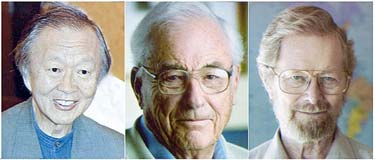redo Jump to...
print Print...
Note: This article is from the British newspaper The Daily Telegraph.
(from Telegraph.co.uk) — Three US physicists – Willard Boyle, George Smith and Charles Kao – have been hailed as the “masters of light” as they were awarded the 2009 Nobel prize for work on fibre optics and light sensors that helped unleash the IT revolution.
The Americans Boyle, Smith and Kao – who has joint British citizenship – were described in an announcement in Stockholm as transforming communications from copper-wire telephony and postal mail to the era of the internet, email and instant messaging.

(From left to right: Charles Kao, Willard Boyle and George Smith.)
“This year’s Nobel Prize in Physics is awarded for two scientific achievements that have helped to shape the foundations of today’s networked societies,” said the Nobel jury.
“They have created many practical innovations for everyday life and provided new tools for scientific exploration.”
One of them is the fibre-optic cable, which enables transmission of data at the speed of light, and the other is the digital sensor that is the digital camera’s “electronic eye”, the jury said.
Kao, who worked for much of his life in Hong Kong, was awarded half of the prize for groundbreaking achievements in the use of glass fibres for optical communication.
“If we were to unravel all of the glass fibres that wind around the globe, we would get a single thread over one billion kilometres [600 million miles] long – which is enough to encircle the globe more than 25,000 times – and is increasing by thousands of kilometres every hour,” the jury said.
The 1966 discovery by Kao, now 75 and retired, means that “text, music, images and video can be transferred around the globe in a split second,” it added.
Boyle, a Canadian-US citizen, and Smith, a 79-year-old American, shared the other half of the prize for inventing an imaging semiconductor circuit – the charge-coupled device (CCD) sensor, which is the “electronic eye” of the digital camera.
The CCD, which converts light into electrical signals was invented in 1969, inspired by the photo-electric theory that earned Albert Einstein the 1921 Nobel.
“It revolutionised photography, as light could be now captured electronically instead of on film,” the committee said.
CCD technology is also used in many medical applications, such as imaging the inside of the human body, both for diagnostics and for microsurgery.
Most digital cameras today use the more efficient CMOS sensor, though the CCD sensor is still used for advanced photography.
Boyle, 85, said that he was in disbelief over winning the prize.
“Wow, this is really quite exciting, but is this real?”
“I haven’t had my morning cup of coffee yet, so I’m feeling a little bit not quite with it all,” he said.
He said he was proud to see the everyday applications of his work in the huge commercial success of digital cameras and pioneering pictures taken by scoutcraft to Mars.
“I see myself all the time these days when I go around and I see everybody using their little digital cameras everywhere … So we are the ones, I guess, that started this profusion of little small cameras working all over the world,” he said.
“I guess the most important part of our invention, which affected me personally, was when the Mars probe was on the surface of Mars and it used a camera like ours … and we saw for the first time the surface of Mars … And it would not have been possible without our invention.”
The Nobel prizes, founded by the Swedish industrialist Alfred Nobel, were first awarded in 1901. This year’s peace prize is due to be awarded on Friday.
Information appearing on telegraph.co.uk is the copyright of Telegraph Media Group Limited and must not be reproduced in any medium without licence. Reprinted here for educational purposes only. May not be reproduced on other websites without permission from the Telegraph. Visit the website at telegraph.co.uk.
Questions
1. Name the three physicists sharing the Nobel physics prize this year.
2. For what reasons did the Nobel jury award these three men the physics prize this year?
3. Charles Kao was awarded half of the physics prize. For what discovery was Mr. Kao awarded the prize?
4. Describe the invention that won George Smith and Willard Boyle the other half of the physics prize this year.
5. What was the most important part of the invention to Mr. Boyle personally?
6. a) In what year were Nobel prizes first awarded?
b) Under what areas of achievement are prizes awarded?
OPTIONAL: Read more about the Nobel Prizes and the Nobel Prize for physics under “Resources” below.
Background
- Every year since 1901 the Nobel Prize has been awarded for achievements in physics, chemistry, physiology or medicine, literature and for peace.
- The Nobel Prize is an international award administered by the Nobel Foundation in Stockholm, Sweden.
- In 1968, Sveriges Riksbank established The Sveriges Riksbank Prize in Economic Sciences in Memory of Alfred Nobel, founder of the Nobel Prize.
- Each prize consists of a medal, personal diploma, and a cash award.
Resources
Read more about the Nobel winners in physics at nobelprize.org/nobel_prizes/physics and about their discoveries/inventions at
nobelprize.org/nobel_prizes/physics/laureates/2009/info.pdf (PDF format-takes a few minutes to load).
Read about the Nobel Prize at nobelprize.org/nobel_prizes/faq.html. (See right vertical nav bar for links to further information on the Nobel Prize.)
Go to nasa.gov/mission_pages/mars/images/pia09028.html for photos of Mars.
Daily “Answers” emails are provided for Daily News Articles, Tuesday’s World Events and Friday’s News Quiz.



